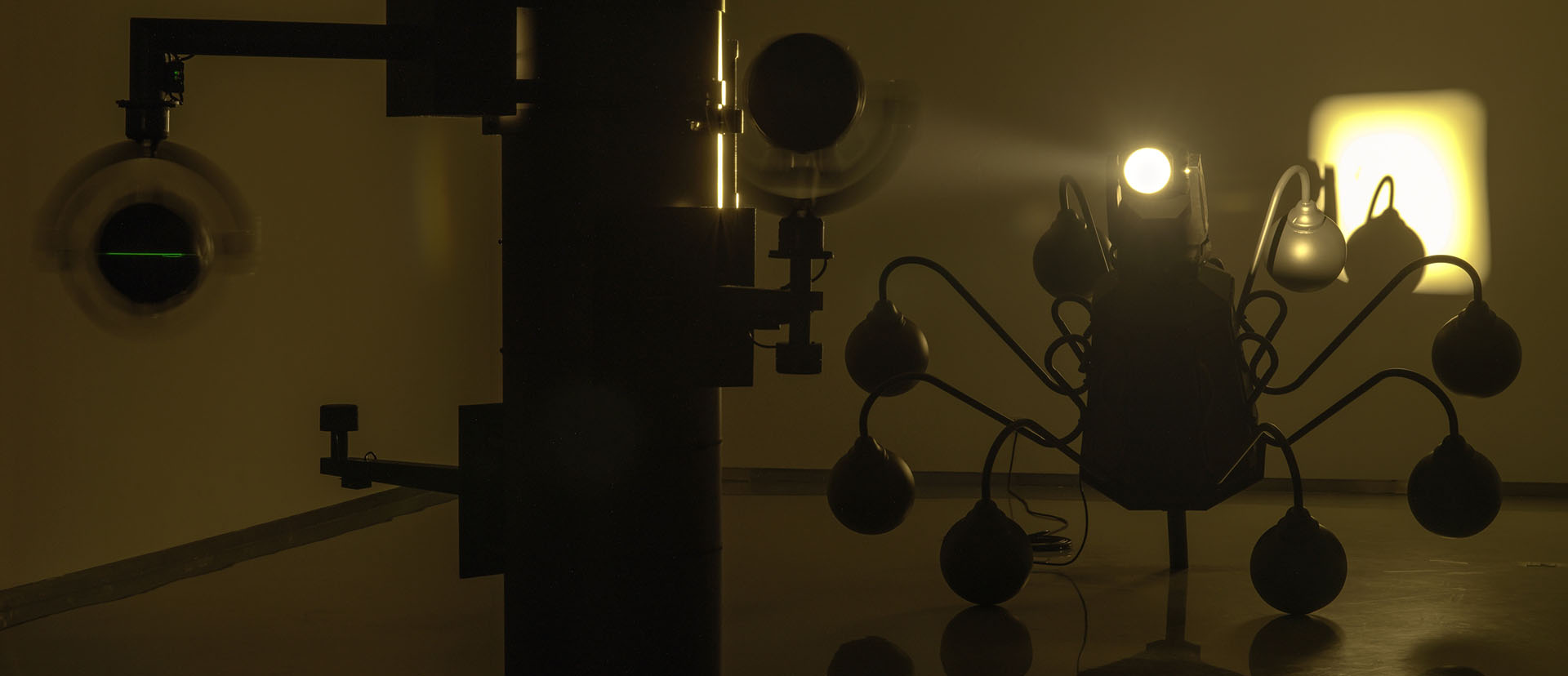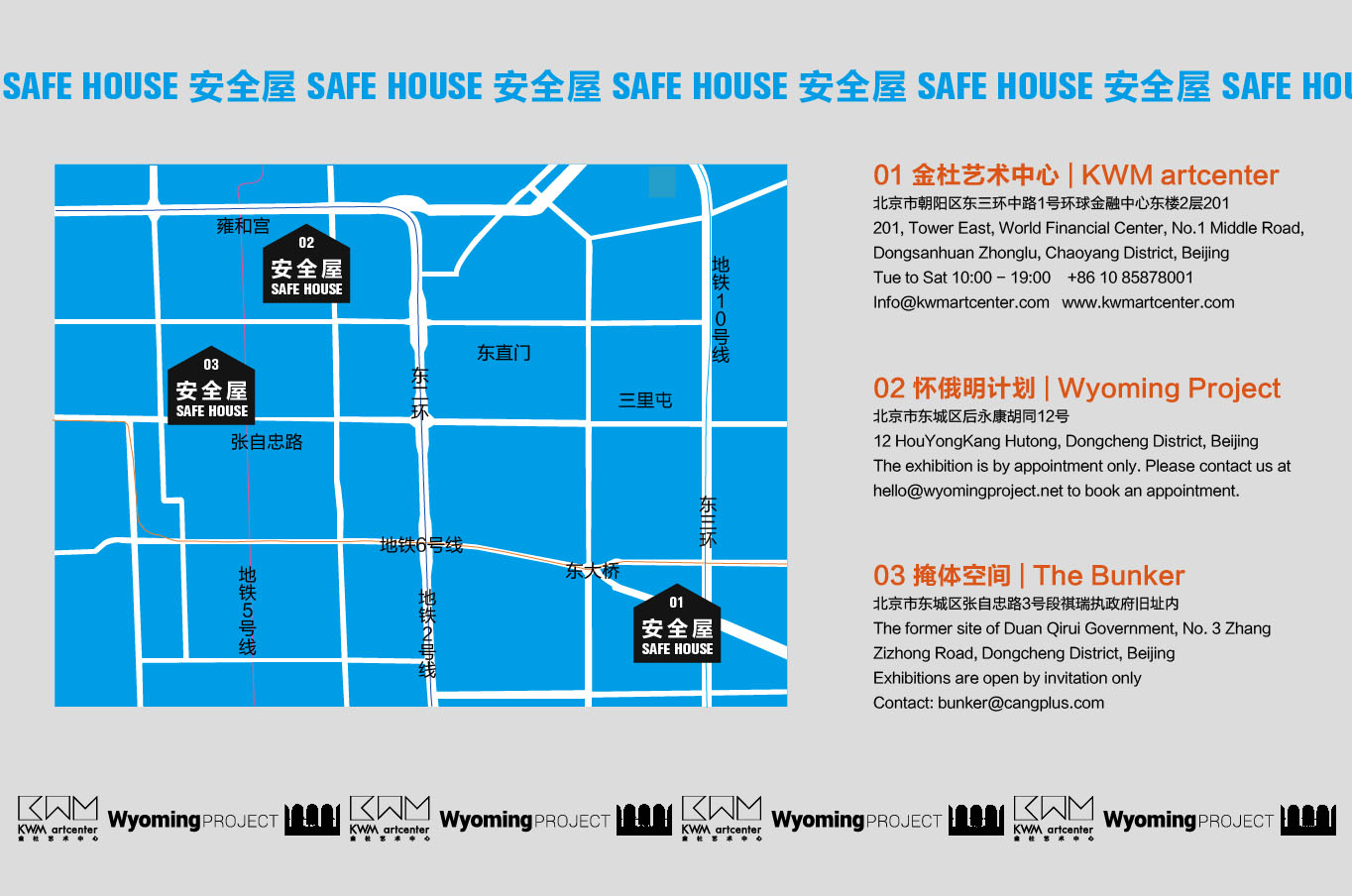
Zhang Ding: Safe House
Artist: Zhang Ding
2018.8.4 – 2018.9.4
Zhang Ding’s art project Safe House, co-initiated by the KWM artcenter, the Wyoming Project and the Bunker will be unveiled on August 4, 2018 in the three spaces simultaneously. By presenting the same concept in three differentiated sites and dimentions, Zhang Ding contructs a discussion that explores the essential spirit of the project.
The Hollow Men
What does a place like this mean to you?
The significant and urgent historical and social responsibilities aside, here we are given an anxious security. Nail biters.
A normal but scarce sense of security comes from self-control, from the freedom of not being controlled, monitored or invaded, from the conspiracy of a prison made by and for oneself, and negative freedom – in many cases, the sole aim of isolating oneself from the outer world is a sense of security, yet the simple and even trivial notion of security pushes us out from ourselves, in relation to the world. That is to say, if absolute seclusion is possible at all, who needs a sense of security?
Formed in a normal, universal, constitutive right is a property, something like a house, that is first of all internalised as a property of our own, when those in the space become a natural extension of the space (cracking up are Descartes, Lefebvre, Merleau-Ponty, Derrida and Nancy; cracking up is even Hao Jingfang). And immediately, soon enough, the property externalises as a property of yours, developing towards your hospitality or hostility as you invite yourself in. Here, we become easily anxious about the interested visitors. The visitors might mean for us communications, developments; every single utterance – interrogations and comebacks – regarding the social, the commercial, the political and the economic pushes our marginalised practise forward, while rendering all parties involved uncomfortable.
In a temporary, shaky two-story construct that comes with an underground vault – we crack up at ourselves, too: We are the hollow men/We are the stuffed men/Leaning together/Headpiece filled with straw. Alas! – Zhang Ding attempts to consolidate the security or insecurity inherent to the building, and its internal-external-art-social relations, to make both you and us tremble with the building. Let’s shake it and dance. Big brother’s many eyes look at you, unwillingly anticipating your abyssal gaze; Big brother sings you a lullaby, ordering you to, politely or rudely think of the space as your own to fall into peaceful slumber; Big brother even disposes a couple of bodyguards here, just in case of any danger; Big brother in a radical fashion demonstrates to you the direct opposite of the damp, pitch-black bunker, denying the melancholy derived from either the long history of the space or the people who wander around in the space like ghosts. Or from your presence. From KWM artcenter to Wyoming Project and to the Bunker, this average journey can mean either an ideal and even optimistic escape from others’ censor that eventually end up in the renouncement of one’s role as his or her own censor and the ultimate achievement of inner self; or, from the Bunker to Wyoming Project then KWM artcenter, a frustrating departure from oneself that is similar to the feeling of unwillingly leaving one’s home.
With the arrival of a global digital surveillance that is proper to the scale of the Anthropocene, a sense of security thins: others’ gaze alone suffices to pop the membrane. It’s sad and funny: when the art world and its “viewing” experience have become more hands-on, “interactive” and “performative” than ever, the world snatches art’s most radical defence mechanism – eyeing – as its sharpest, most invasive and corrosive weapon. Big brother doesn’t need to do anything other than putting us in his sight.
The three-story of KWM artcenter, Wyoming Project and the Bunker are not connected by stairs or ladders whatsoever. In this last of meeting places/We grope together/And avoid speech/Gathered on this beach of the tumid river. Zhang Ding was a cage, a butcher’s shop, and a brewery. This time, he flow from one story to another, is a river. As shaky as the three-story construct, as shaky and dangerous as a sense of security. Tripod is a myth.
About the Artist
Zhang Ding
born in 1980 in Gansu, China, lives and works in Shanghai.
Zhang Ding’s practice is mainly presented through his solo projects, including videos, installations, paintings and live performances, etc. Starting from Tools (2007), constructing absurd scenes full of contrasts and conflicts that focus on sensory perception and will power became his way of demonstrating and interpreting metaphors of societal references, which may also be seen as a series of deconstructed mise en scenes. The scenic displacement created a psychic displacement whereby we were confronted with our imperfect senses, our ‘fallible omniscience’.
In Opening (2011), live performance was brought into his project for the first time, and remained to presenting all the way to Orbit of Rock (2014). In these projects, chemical interaction generated by all the in-between stimulation transformed the sites into environmental sculpture of twisting emotion and atmosphere. From Enter the Dragon series, Zhang Ding experimented further and explored more possibilities in his work by opening up the sole artistic authorship to the public – 26 musicians of various genres and styles were invited to collaborate in spinning mirror maze by making improvisation with each other at the ICA London (2015); the sensory challenges was updated over and over again by the variable space and participation of the Chinese musicians at the chi K11 Museum Shanghai (2016) then extended to the Enter The Dragon III Singapore.
In 2016, Devouring Time, Zhang Ding transformed the Rockbound Art Museum into a golden jail, and live-streamed the event of 150 VIPs having dinner party together. The same year he also initiated the art label CON TROL CLUB, which is the parties of both controllability and anti-controllability by integrating of geeks, immersive A/V installations, music etc. The launch project was activated by his sound installations and legendary musician Wang Fan at a historical ruin in Shanghai. In 2017, ZHANG Ding was back to the gallery space for creating an immense VORTEX in the ShanghART Shanghai……
KWM artcenter
The KWM artcenter opened on 20th October 2016. It is located on the second floor of the WFC centre CBD in Beijing. The Art center is supported by the law firm King & Wood Mallesons. The KWM artcenter presents and promotes artists both domestically and overseas as well as building up its own collection. In particular, it acts as a rare art institution at the heart of the economic central area in Beijing. It provides high-quality art educational activities and courses aimed to cultivate art lovers and collectors. It serves to improve the international influence of Chinese Art and become a powerful communicator of Chinese Contemporary Art.
Contact:Info@kwmartcenter.com|+86 10 85878001|www.kwmartcenter.com
Opening Times: Tuesday to Saturday 10:00 -19:00
Address:201, Tower East, World Financial Centre, No.1 Dongsanhuan Zhonglu Chaoyang District,Beijing,China
Wyoming Project
Founded in 2017, Wyoming Project sometimes does exhibitions and publications.
Contact:hello@wyomingproject.com
Address:No.12 Houyongkang Hutong,Dongcheng District,Beijing,China
The Bunker
Built in 1941 at No. 3 Zhang Zizhong Road, Beijing,the building that houses The Bunker was originally used as the under ground command centre for General Yasuji Okamura, commander-in-chief of the Japanese occupying forces’Northern China Area Army. The architectural compoundit is part of was central to the turbulent times of early China republican history. It was originally constructed in 1906 to house the offices for the Qing Dynasty’s navy and army until the rule of President Li Yuanhong of China’s Republican era, and then it became the administrative offices for Priemier minister Duan Qirui of the Nationalist government. Ever since 1949 it has been used by People’s University. In 2017, The Bunker is being established at this historically loaded site to provide a platform for artistic experimentation.
Contact:bunker@cangplus.com|13901189731
Address: The former site of DuanQirui Government, No.3 Zhangzizhong Road, Dongcheng District, Beijing, China.

